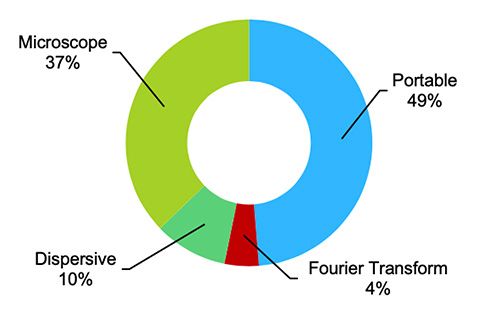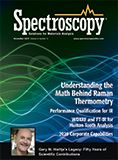Market Profile: Raman Spectroscopy
The total market for Raman spectroscopy instruments was measured at over $300 million in 2018 with around 4500 units shipped annually.
Raman is a lesser known light scattering phenomenon by which an excited electron returns to a different rovibronic state than before in molecules, and the extra energy changes the vibrational mode of the particle. This causes a photon to be emitted at a different frequency than before. Raman spectroscopy uses this phenomenon to identify different substances according to their molecular structure. In Raman spectrometers, after scattering occurs through a sample using lasers, the resulting photons are sent through a monochromator and guided to a charge-coupled device for signal analysis using band filters and sometimes a Fourier transform analysis.
Raman technology is a relatively old form of spectroscopy that became more prevalent after the development of lasers. Raman scattering was discovered by C. V Raman in 1928, and Raman used a mercury lamp and photographic plates to record spectra. However, this archaic process took hours or days to acquire spectra due to weak light sources.
Raman spectroscopy can be applied to many fields where nondestructive chemical analysis and microscopic imaging needs to be provided rapidly. It can analyze many states of matter such as solid, liquid, gases, and even gels and slurries. It is used in a variety of applications such as pharmaceutical, cosmetic, material, semiconductor, and life science industries and research. The most common types of Raman spectrometers are microscopes, portable, dispersive, and Fourier transform, with portable Raman spectrometers being the highest selling instruments. Vendors such as Acutech, B&W Tek, and Spectra Solutions provide portable Raman spectrometers. Cloudminds Technology has a palm sized Raman spectrometer that uses cellular, WiFi, or Bluetooth to communicate with their AI cloud.
The total market for Raman spectroscopy instruments was measured at over $300 million in 2018 with around 4500 units shipped annually. Portable spectrometers account for the largest share of the market with nearly half of the market. In the past decade, the market has significantly shifted to portable devices rapid and flexible analysis.
Raman spectroscopy market demand in 2018 by instrument.

Market size and growth estimates were adopted from TDA’s Industry Data, a database of technology market profiles and benchmarks covering laboratory and process analytical instrumentation that are updated quarterly. It also includes data from the 2020 Instrument Industry Outlook report from independent market research firm Top- Down Analytics (TDA). For more information, contact Glenn Cudiamat, general manager, at +1 (310) 871-3768 or glenn.cudiamat@tdaresearch. com. Glenn is a market research expert who has been covering the analytical instrumentation industry for more than two decades.

Market Profile: Mass, Molecular, and Atomic Spectroscopy
December 1st 2018Mass spectrometry, molecular and atomic spectroscopy technologies combine to represent more than a fifth of the overall market for laboratory analytical instrumentation. These techniques are perhaps the most broadly used instruments, with utility in pharmaceuticals and other life sciences, chemicals, environmental, food, clinical/Dx and other applications.